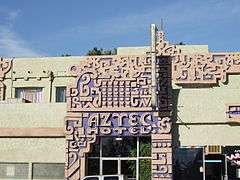Aztec Hotel
|
Aztec Hotel | |
|
Part of the facade of the hotel | |
   | |
| Location | 311 W. Foothill Blvd., Monrovia, California |
|---|---|
| Coordinates | 34°9′6″N 118°0′18″W / 34.15167°N 118.00500°WCoordinates: 34°9′6″N 118°0′18″W / 34.15167°N 118.00500°W |
| Built | 1924 |
| Architect | Robert Stacy-Judd |
| Architectural style | Mayan Revival |
| NRHP Reference # | 78000691[1] |
| Added to NRHP | May 22, 1978 |
The Aztec Hotel is a historical landmark building in Monrovia, in the San Gabriel Valley, California. The Hotel is one of the outstanding examples of Mayan Revival architecture still in existence. It was designed by architect Robert Stacy-Judd, and built on the legendary original U.S. Route 66 in 1924. Closed for renovations in 2012, there is little prospect of the hotel reopening until 2015 or later.[2]
History
This was Stacy-Judd's first commissioned job in the United States. He had designed theaters with an Egyptian theme in England. Robert Stacy-Judd focused on designing the facades and furniture, incorporated abstract patterns that were loosely inspired by Maya hieroglyphs. The revivalist style was popular during the 1920s–30s, an abstraction from Maya architecture sources with art deco and Spanish Colonial Revival architecture influences. Besides the beautiful lobby, banquet room and adjoining patio, the Aztec houses the Mayan Bar and Grill (Brass Elephant).[3]
Some of his other notable Southern California commissions include the First Baptist Church, (Ventura), the Masonic Temple (North Hollywood, California), the Philosophical Research Society, (Los Feliz) and the Atwater Bungalows, (Elysian Park).
The hotel was featured in the 2009 romantic comedy Spooner. Scenes were filmed in front of the hotel as well as many interior scenes showing the lobby, bar, hallways and inside one of the rooms.
The style
The other architect known for working in this style was Frank Lloyd Wright. In Los Angeles his Hollyhock House, Ennis House, and Millard House (La Miniatura) are relevant examples. The Imperial Hotel in Tokyo was a zenith of this style. His son, the landscape architect and architect Lloyd Wright, designed the John Sowden House in a similar style.
Landmark status
The Aztec Hotel was designated a National Historic Landmark and listed on the National Register of Historic Places in 1978.[1] The hotel's owners began restoration to preserve as much of the original ornamentation as possible in 2000 under the National Park Service's Route 66 Corridor Preservation Program.[4]
References
- Notes
- 1 2 National Park Service (2008-04-15). "National Register Information System". National Register of Historic Places. National Park Service.
- ↑ Historic Aztec Hotel in Monrovia could reopen in 2015
- ↑ Flickr:Aztec Hotel gallery. accessed 4/11/2010.
- ↑ "Aztec Hotel, Monrovia, California". Route 66: Discover Our Shared Heritage Travel Itinerary. National Park Service. Retrieved 24 April 2014.
- Further reading
- Gebhard, David and Peres, Anthony. Robert Stacy-Judd: Maya Architecture and the Creation of a New Style. Capra Press. 1993.
- Ingle, Marjorie I. The Mayan Revival Style: Art Deco Mayan Fantasy. University of New Mexico Press. 1989.
